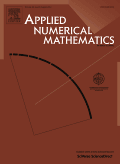
Applied Numerical Mathematics
Scope & Guideline
Innovating Solutions Through Rigorous Research.
Introduction
Aims and Scopes
- Numerical Methods for Differential Equations:
The journal extensively covers numerical methods for both ordinary and partial differential equations, including implicit and explicit schemes, finite element methods, and spectral methods, with a focus on stability and convergence. - Stochastic and Random Processes:
There is a significant emphasis on the numerical analysis of stochastic differential equations and their applications in fields such as finance, biology, and physics, highlighting techniques for handling randomness and uncertainty. - Fractional Calculus and Integro-Differential Equations:
The journal features research on fractional calculus, including numerical methods for fractional differential equations and integro-differential equations, reflecting the growing interest in non-integer order derivatives. - Computational Methods for Complex Systems:
Research articles often address computational techniques for simulating complex physical systems, such as fluid dynamics, heat transfer, and biological processes, utilizing methods like multi-scale modeling and adaptive mesh refinement. - Error Analysis and Algorithm Development:
The journal emphasizes rigorous error analysis of numerical algorithms, promoting the development of new methods that improve accuracy and efficiency in computational tasks. - Applications in Engineering and Science:
Applied Numerical Mathematics publishes studies that apply numerical methods to real-world problems in engineering, physics, and other scientific disciplines, demonstrating the practical relevance of theoretical developments.
Trending and Emerging
- Machine Learning and Data-Driven Methods:
There is an increasing trend towards integrating machine learning techniques into numerical methods, particularly in optimization, data analysis, and solving differential equations. - Multiscale and Multiphysics Problems:
Research focusing on multiscale and multiphysics problems is gaining traction, driven by the need to model complex interactions in physical systems, as seen in applications like fluid-structure interactions and biological processes. - Adaptive and High-Order Methods:
Emerging methods that emphasize adaptivity and high-order accuracy are becoming more prevalent, allowing for more efficient computations in complex domains and improving the accuracy of numerical solutions. - Numerical Techniques for Fractional Differential Equations:
There is a growing interest in numerical methods specifically designed for fractional differential equations, reflecting their increasing importance in modeling real-world phenomena. - Stochastic Modeling and Uncertainty Quantification:
The application of numerical methods to stochastic models and uncertainty quantification is trending, showcasing a shift towards addressing randomness and variability in mathematical modeling.
Declining or Waning
- Traditional Numerical Linear Algebra:
The focus on classical topics in numerical linear algebra has waned, as researchers increasingly explore more specialized or advanced techniques, such as tensor methods and machine learning approaches in numerical computations. - Basic Finite Difference Methods:
There appears to be a decrease in the number of papers dedicated to basic finite difference methods, as the field moves towards more sophisticated approaches such as high-order and adaptive methods. - Low-Dimensional and Simplistic Models:
Research on low-dimensional models or simplistic approaches to numerical problems has decreased, with a growing emphasis on complex and multi-dimensional systems that require more advanced numerical techniques.
Similar Journals

Punjab University Journal of Mathematics
Elevating the discourse of theoretical and applied mathematics.Punjab University Journal of Mathematics is a prestigious academic journal published by the Department of Mathematics at the University of Punjab, Pakistan. Dedicated to advancing the field of mathematics, this journal provides a platform for researchers, educators, and students to disseminate their findings, foster scholarly dialogue, and promote innovative mathematical research. With a strong focus on theoretical and applied mathematics, the journal maintains a rigorous peer-review process to ensure high-quality publications that significantly contribute to the mathematical community. Although currently not indexed in prominent databases, the journal aims to elevate its visibility and impact through consistent publication of cutting-edge research. The absence of Open Access reflects a commitment to quality and thorough review, but researchers are encouraged to seek out this valuable resource for its insights and diverse contributions to mathematics.

Numerical Mathematics-Theory Methods and Applications
Empowering Research with Cutting-Edge MethodologiesNumerical Mathematics: Theory Methods and Applications, published by GLOBAL SCIENCE PRESS, stands as a pivotal journal in the fields of applied and computational mathematics, control and optimization, as well as modeling and simulation. With an ISSN of 1004-8979 and an E-ISSN of 2079-7338, this journal has been committed to disseminating high-quality research since its establishment in 2010, curating contributions that reflect the latest advancements in numerical methodologies and their diverse applications. As a Q2 journal in its category for 2023, it ranks favorably in the Scopus metrics, with notable positions in various mathematical disciplines. Although it does not currently provide open access, it remains an essential resource for researchers and professionals seeking to deepen their understanding of numerical methods and their applications. The journal’s esteemed reputation, coupled with its strategic focus on emerging trends in mathematics, makes it an invaluable platform for scholars who wish to contribute to and stay informed about cutting-edge developments in this dynamic field.
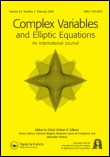
Complex Variables and Elliptic Equations
Driving Innovation in Numerical and Computational AnalysisComplex Variables and Elliptic Equations is a distinguished academic journal published by TAYLOR & FRANCIS LTD, focused on the intricate interplay between complex variables and elliptic equations. With an ISSN of 1747-6933 and an E-ISSN of 1747-6941, this journal serves as a vital platform for researchers and practitioners in the fields of Analysis, Applied Mathematics, Computational Mathematics, and Numerical Analysis. With a publishing history spanning from 2007 to 2024, the journal is recognized for its substantial contributions, as evidenced by its Q2 ranking in Applied Mathematics and Numerical Analysis, and Q3 in Analysis and Computational Mathematics for 2023. Notably, it occupies various Scopus ranks that reflect its ongoing academic relevance—ranked #86 in Mathematics Analysis and #49 in Numerical Analysis. While it does not currently operate under an open-access model, the journal remains an indispensable resource for advancing mathematical theory and its practical applications. Researchers, students, and professionals alike will find invaluable insights and developments that push the boundaries of mathematical inquiry.

NUMERICAL METHODS FOR PARTIAL DIFFERENTIAL EQUATIONS
Empowering researchers with cutting-edge numerical techniques.Numerical Methods for Partial Differential Equations is a prestigious academic journal published by Wiley, dedicated to advancing the field of numerical analysis and computational mathematics. With a prominent standing reflected in its Q1 rankings across multiple categories including Analysis, Applied Mathematics, Computational Mathematics, and Numerical Analysis, this journal serves as a vital resource for researchers, professionals, and students alike. Since its inception in 1985, NUMERICAL METHODS FOR PARTIAL DIFFERENTIAL EQUATIONS has consistently published high-quality, peer-reviewed articles that explore innovative numerical techniques and their applications across disciplines. The journal is indexed in leading databases, ensuring broad visibility and access for its contributors. Aimed at fostering cutting-edge research, it invites submissions that provide new insights and methodologies for solving complex partial differential equations, making it an essential source for anyone interested in the intricacies of mathematical analysis and computational techniques.
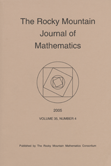
ROCKY MOUNTAIN JOURNAL OF MATHEMATICS
Pioneering Research for a Dynamic Mathematical CommunityROCKY MOUNTAIN JOURNAL OF MATHEMATICS, published by the Rocky Mountain Math Consortium, serves as a critical platform for researchers and practitioners in the field of mathematics since its inception in 1971. With a notable presence in the academic community, this journal covers a broad spectrum of mathematical disciplines, positioning itself in the Q2 category for Mathematics (miscellaneous) as of 2023. Despite being a subscription-based journal, it is recognized for its rigorous peer-review process and contributions to theoretical and applied mathematics, helping to advance knowledge and foster collaboration among mathematicians. The journal's ISSN number is 0035-7596 and its E-ISSN is 1945-3795, reflecting its commitment to accessibility and dissemination of high-quality research. Based in Tempe, Arizona, at Arizona State University, the journal continues to play an important role in shaping contemporary mathematical discourse through well-researched articles and innovative studies, aiming to bridge gaps between various mathematical subfields and engage a diverse audience, including students and established researchers alike.

CALCOLO
Fostering Collaboration in Algebra and BeyondCALCOLO is a prestigious academic journal published by Springer-Verlag Italia SRL, focusing on the fields of Algebra, Number Theory, and Computational Mathematics. Established in 1964, this journal has made significant contributions to advancing mathematical theory and applications. It holds a commendable Impact Factor and ranks in the Q1 quartile for Algebra and Number Theory, underscoring its importance and influence in the field. With a Scopus Rank of #17 out of 119 in Algebra and Number Theory, CALCOLO is recognized for publishing high-quality research that propels the discipline forward. Researchers and professionals in the mathematical community will find CALCOLO an essential resource, providing access to pioneering studies and fostering collaborations. While the journal currently does not offer an open access option, it continues to engage with emerging topics and innovative methodologies, ensuring it remains at the forefront of mathematical research through 2024 and beyond.

Frontiers of Mathematics
Charting New Paths in the Realm of MathematicsFrontiers of Mathematics, published by SPRINGER HEIDELBERG, is an emerging academic journal dedicated to fostering the advancement of mathematical sciences from 2023 to 2024. With an ISSN of 2731-8648 and E-ISSN of 2731-8656, this journal is positioned in the category of Q2 in the miscellaneous mathematics domain, showcasing its commitment to quality research and innovation. Although in its nascent stages, it has swiftly established a foothold within the global academic landscape, holding a Scopus rank of #198/399 and a median percentile of 50, indicating a promising trajectory. By providing an open-access option, Frontiers of Mathematics ensures broad dissemination of research findings, fostering collaboration and knowledge sharing across the mathematical community. Researchers, professionals, and students alike will find this journal to be an invaluable resource, contributing to important discussions and advancements in various mathematical fields.
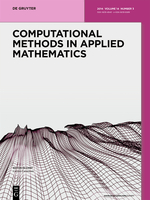
Computational Methods in Applied Mathematics
Bridging Theory and Practice in Applied MathematicsComputational Methods in Applied Mathematics is a premier academic journal published by WALTER DE GRUYTER GMBH, based in Germany. With its ISSN 1609-4840 and E-ISSN 1609-9389, this journal serves as a crucial platform for the dissemination of cutting-edge research and innovations in the fields of Applied Mathematics, Computational Mathematics, and Numerical Analysis. Notably, it has been recognized in 2023 with a Q2 ranking in its category quartiles, marking it as a significant contributor in its discipline. Spanning from 2001 to 2024, it fosters interdisciplinary collaboration and exploration of computational methodologies that solve complex mathematical problems. Though it operates on a traditional access model, its relevance is underscored by its Scopus rankings, which place it among the notable leaders in its area. As a trusted source of scholarly articles, Computational Methods in Applied Mathematics is an essential resource for researchers, professionals, and students aiming to stay abreast of advancements and discussions that shape the future of applied mathematics.

Communications on Applied Mathematics and Computation
Catalyzing Collaboration in the Mathematical SciencesCommunications on Applied Mathematics and Computation is a distinguished journal published by SpringerNature, dedicated to advancing the fields of Applied Mathematics and Computational Mathematics. With its ISSN 2096-6385 and E-ISSN 2661-8893, the journal has established itself as a critical platform for researchers seeking to disseminate their findings and engage with contemporary mathematical challenges. Recognized in the Q2 quartile of both Applied Mathematics and Computational Mathematics categories for 2023, it ranks impressively within its field, holding the 278th position in a pool of 635 journals for Applied Mathematics and the 89th out of 189 for Computational Mathematics, indicative of its scholarly impact. The journal facilitates open access to a plethora of pioneering research, promoting collaboration and innovation in a global academic community. With a commitment to high-quality publications from 2019 through 2024, Communications on Applied Mathematics and Computation serves as an essential resource for scholars and practitioners aiming to bridge theory and practical applications in mathematics.
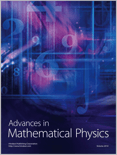
Advances in Mathematical Physics
Unlocking New Dimensions in Scientific InquiryAdvances in Mathematical Physics is a premier open-access journal published by HINDAWI LTD, dedicated to the dissemination of research in the fields of applied mathematics and physics. With its ISSN 1687-9120 and E-ISSN 1687-9139, this journal has been a vital platform for innovative studies since its inception in 2009, fostering a collaborative environment for researchers and professionals alike. The journal features a wide range of topics, including but not limited to mathematical models, computational physics, and interdisciplinary applications, thus attracting a diverse readership. Ranked in the Q3 quartile for both Applied Mathematics and Physics and Astronomy, it serves as a significant resource for academics looking to explore cutting-edge developments and theoretical advancements. With an emphasis on open accessibility, Advances in Mathematical Physics ensures that research findings are readily available to the global academic community, leveling the playing field for emerging scholars and seasoned researchers. By consistently showcasing high-quality manuscripts, the journal contributes substantially to the fields of mathematics and physics, encouraging scholarly dialogue and advancing knowledge across a myriad of applications.